India: Land of Eternal Ink
Article © 2009 Lars Krutak
Mysore
Around 1900, Korathi (Gypsy) women
tattooed both sexes through a form of
pricking (Fig. 12). Sometimes they inked
intricate kolam designs on their clients or
other motifs to aid in beautification (Figs.
13 & 14).
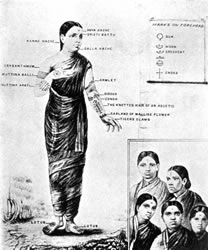 |
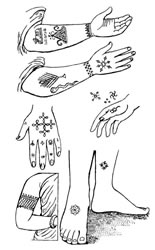 |
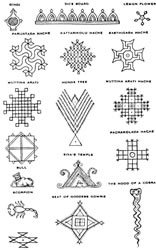 |
|
Fig. 12) Tattoos of Mysore |
Fig. 13) Tattoos of Mysore |
Fig. 14) Kolam & other Mysore tattoos
|
Korathi artists were nomadic and roamed
about the country in every direction. Their
fees consisted of rice, plantains, betel
leaves and nuts, and sometimes they were
enhanced by a present of cash.
The artist generally pronounced a
benediction for the welfare of the
individual to be tattooed, and then she
began the operation. While plying her
client's skin, she chanted nursery rhymes or
sang Gopika Gita songs with the object of
making the person undergoing the operation
disregard the pain. One example of a Korathi
tattoo song sung during the operation
follows:
"Stay, darling stay - 'tis only for
an hour,
And you will be the fairest of the fair,
Your lotus eyes can soothe the savage
beast,
Your lips are like the newly blossomed
rose,
Your teeth, they shine like pearls; but
where are they
Before the beauties of the handwork.
"Stay, darling stay - 'tis only for an
hour,
And you will be the fairest of the fair,
I've left my home, all day long I toil,
So to adorn the maiden of the land,
That erring husbands may return to them,
Such are the beauties of my handwork.
"Stay, darling stay - 'tis only for an
hour,
And you will be the fairest of the
world,
In the days of old, fair Sita laid her
head,
Upon the lap of one of our clan,
When with her lord she wandered in the
wild,
And like emerald shone her beauteous
arms.
"Stay, darling stay - 'tis only for an
hour,
And you will be the fairest of the fair,
And often in the wilds, so it is said,
She also of the Pandus went in quest,
Of one of us, but found not even one,
And sighed, she was not her sister's
blest.
"Stay, darling stay - 'tis only for an
hour,
And you will be the fairest of the fair,
My work is done, rejoice, for you will
be,
The fairest of your sisters in the land,
Rejoice for ever more, among them you,
Will shine as doth Moon among the
stars."
The pricking instrument usually consisted
of three or more needles tied together with
a thread. The pattern was selected from a
bundle of drawings, and was first traced on
the skin with a small pointed stick, dipped
in the prepared ink that is pricked in with
the needles. The part of the skin to be
tattooed is washed in cold water, and a coat
of ink rubbed over the surface. To allay the
pain, a little coconut oil is applied to the
wound. A small quantity of turmeric powder
is also added to brighten the color and to
prevent swelling. It was said that some of
the pigments used in tattoo were known to
the ancient doctors of India, and this led
to the suggestion that the custom had been
recorded of persons tattooed on their chests
and shoulders with the object of getting rid
of pain - usually rheumatism.
A variety of pigments were utilized: 1)
Betel-leaf juice is smeared over a new tile
which is exposed to the flame of a castor
oil lamp to cause the soot to deposit
thereon. The soot is then mixed with cow's
milk or women's breast milk; 2) Human milk
is mixed with the soot adhering to the
bottom of an earthen frying pan; 3) the
juice of Dolichos lablab l. is spread over
the convex surface of a new tile, then
turmeric powder is sprinkled over it. The
tile is held over the flame of a gingelly or
castor oil lamp to form soot, which is then
scraped with a twig and kept in a small
earthen vessel ready to be used, at any
moment, with a little water added to it.
Tattoo clients believed that their marks
acted as a passport for the forgiveness of
sins and admission to heaven. The absence of
tattoo marks was believed to invoke the
displeasure and condemnation of Yama, the
god of death. Some forms of tattooing were
also believed to act as talismans and to
bring riches to those who bear them. And in
some regions of Mysore it was also reported
that Hindu women who were not tattooed with
certain designs were considered unclean;
they were prohibited from touching corn
spread upon the threshing floor or to serve
at dinner.
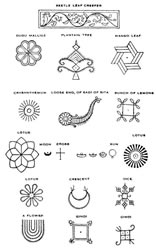 |
|
Fig. 15) Tattoos from
nature |
According to other Hindu traditions
recorded around 1910 in the area, Vishnu is
said to have tattooed the hand of Lakshmi
with the figure of his weapons, and with
that of the Sun, Moon and Tulsi plant (Ocimum
sanctum) as a protection for her during his
wars with demons (Fig. 15). It was told that
he promised to protect those who wore the
same marks from all evil influences.
Moreover, Lord Krishna was in the habit of
tattooing his four totems, the sankh
("conch"), the chakra ("wheel"), gada
("mace"), and padma ("lotus") on the faces
and limbs of his wives. The priests of the
ancient city of Dwaraka placed some of these
marks on the arms of the pilgrims to
Krishna's shrine.
Another tradition attributed to tattooing
is to Sita, the wife of Rama. The alleged
reason is the belief that tattooing had its
origin in the fear of enemy abduction of the
indigenous women of India. The tribal marks
among the crude drawings would help them in
identification and included ornaments,
religious drawings, charms and symbols.
Of course, there are still more tattooed
referents to the Hindu pantheon and
sympathetic magic. A dot on the forehead is
a symbol of Lakshmi, the goddess of wealth.
A tattoo of Sita is the emblem of chastity.
The figure of a peacock indicates royalty. The
fish is the symbol of fertility and good
luck, and the comb is a symbol of happy
married life. It was also recorded that
individuals who worshipped Ganesh and who
were about to be tattooed practiced the
following ritual: "They stick green grass
into a ball of cow-dung to represent the god
Vinayaka [Ganesh], burn frankincense and
offer coconuts into a fire, as this is
supposed to avert the effect of the evil
eye."
Madras
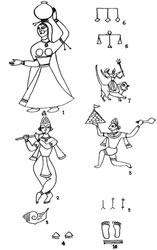 |
|
Fig. 16) 1) Pāniāri, 2) Krishna, 3) Conch, 4) Feet of Rama, 5-6) Kāvad, 7) Kali, 8) Hanuman, 9) Holy Men, 10) Footprints of Ramdevji
|
Like their counterparts in Mysore, the
tattoo artists of Madras were always women
who traveled the countryside in search of
clients. They departed Madras during the
harvest season and made professional visits
to the neighboring districts, traveling as
far as Pondicherry in the south and Cuddapah
in the north. Their clients included Brahmin
women, other Hindus, Paraiyas, and Tamil
Muslims. The patterns ranged from a dot or
straight line to complex geometrical
designs. Sometimes motifs from the domain of
nature were given including scorpions,
birds, fishes, and flowers like the lotus -
some of which are symbols of luck. Among
women, many parts of the body were selected
for tattooing including the arms, forelegs,
forehead, cheeks, and chin.
Occasionally, in cases of muscular pain
or other disorders, the tattoo "operation"
was performed as a remedial agent over the
shoulder joint, or on the thigh, or other
parts of the body. One report noted the case
of a Bedar man in the Bellary district who
had dislocated his shoulder and had been
tattooed with the figure of Hanuman to
relieve the pain. Hanuman is the monkey king
and ally of Rama in the Hindu epic Ramayana
(Fig. 16).
A legend runs to the effect that many
years ago, a Paraiya woman wished her upper
arms and chest to be tattooed in the form of
a bodice. The operation was successfully
performed until the region of the heart was
reached. Unfortunately, the tattoo needles
punctured the vulnerable organ and the woman
died, and since that time has arisen a
superstitious objection to tattooing of the
breasts.
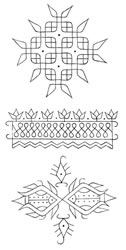  |
|
Fig. 17 & 18) Tamil
kolam tattoos |
According to a 1906 report, the Tamil
equivalent of tattooing was called pachai
kuthikiridu, or pricking with green (Figs.
17 & 18). Traveling Korava women who are
also fortune tellers were the tattooists and
their ink was prepared in the following
manner. Turmeric powder and the leaves of
Sesbania grandiflora were ground together in
a mortar or on a grinding stone. The mixture
was spread on a thin cloth, and rolled up in
the form of a wick, which was then placed in
an open lamp charged with castor oil. The
wick was lit, and the lamp covered with an
earthen pot upon which the lampblack was
deposited. This soot is scraped off, and
mixed with mother's milk or water. The
pricking instrument was comprised of three
or four more sewing needles fastened
together with thread.
Tattoo patterns were selected from a
bundle of drawings on paper which were
created by the artist. She first traced the
desired motif on the skin with a blunt stick
dipped in the prepared ink, and then
proceeded to prick-in the tattoo. Once
completed, the tattoo was washed with cold
water, and a coat of pigment rubbed over the
surface of the design. To decrease the pain,
an unidentified oil was applied to the wound
and a small quantity of turmeric powder was
rubbed-in to brighten the color and prevent
additional swelling.
Korava artists were able to execute
complicated patterns with considerable
dexterity. Because most of them were
illiterate, they were unable to tattoo
initials or names unless they were first
drawn for them. That being said, they were
also reported to have the ability to tattoo
any pattern, no matter the complexity,
provided that it was illustrated for them.
Even as early as 1910, it was documented
that intricate Burmese patterns were being
copied by Korava tattooists in Madras.
Around 1910, the tattooer's fee
reportedly ranged from a 1/4 anna (e.g., one
anna is equivalent to 1/16 of a rupee today)
for a dot or line to twelve annas for a
complex design. In rural villages payment
appears to have been made in-kind, and a
present of rice to be the usual
remuneration.
Next Page
|
1 | 2 |
3
|
4
|
5
|







